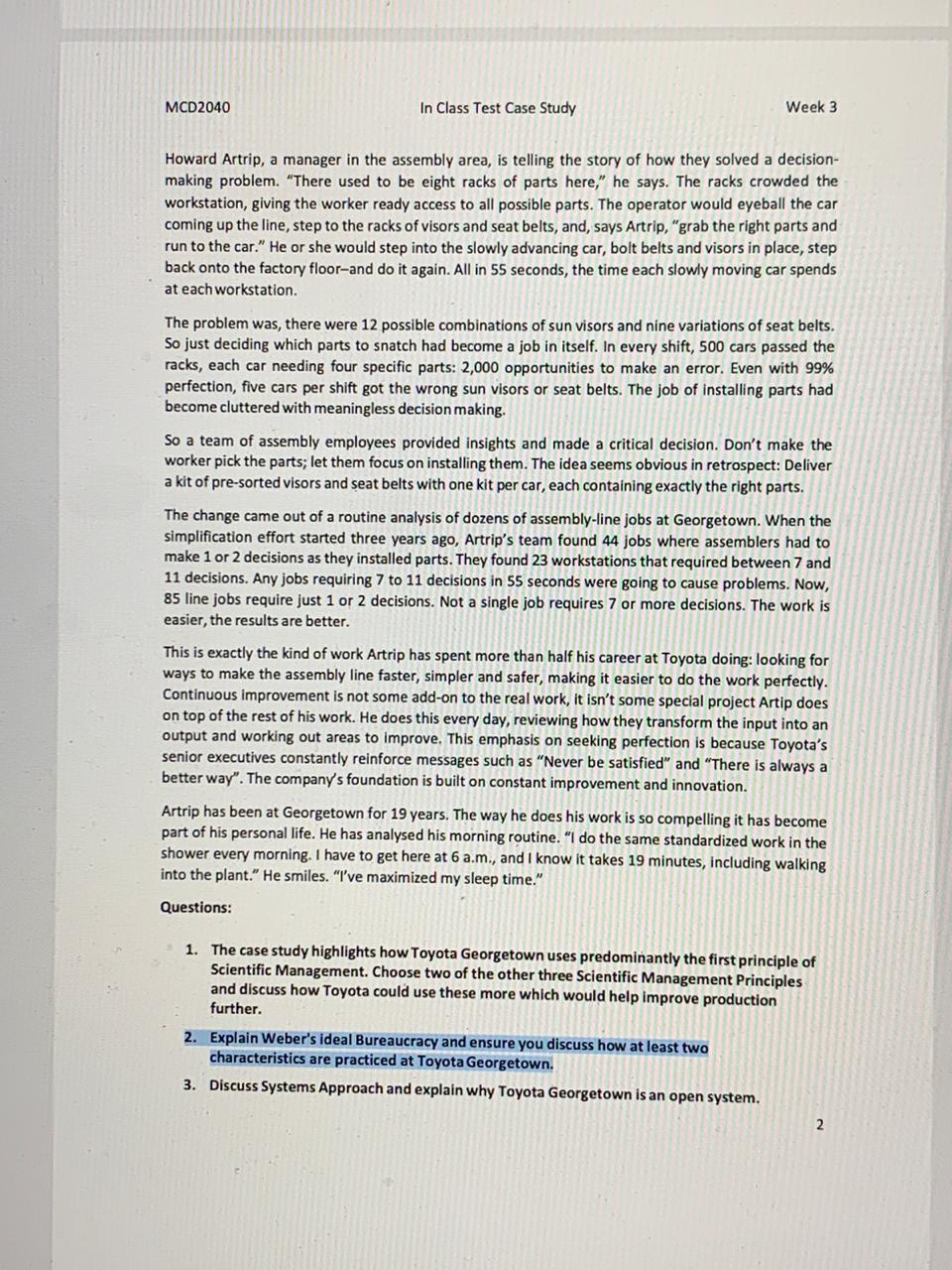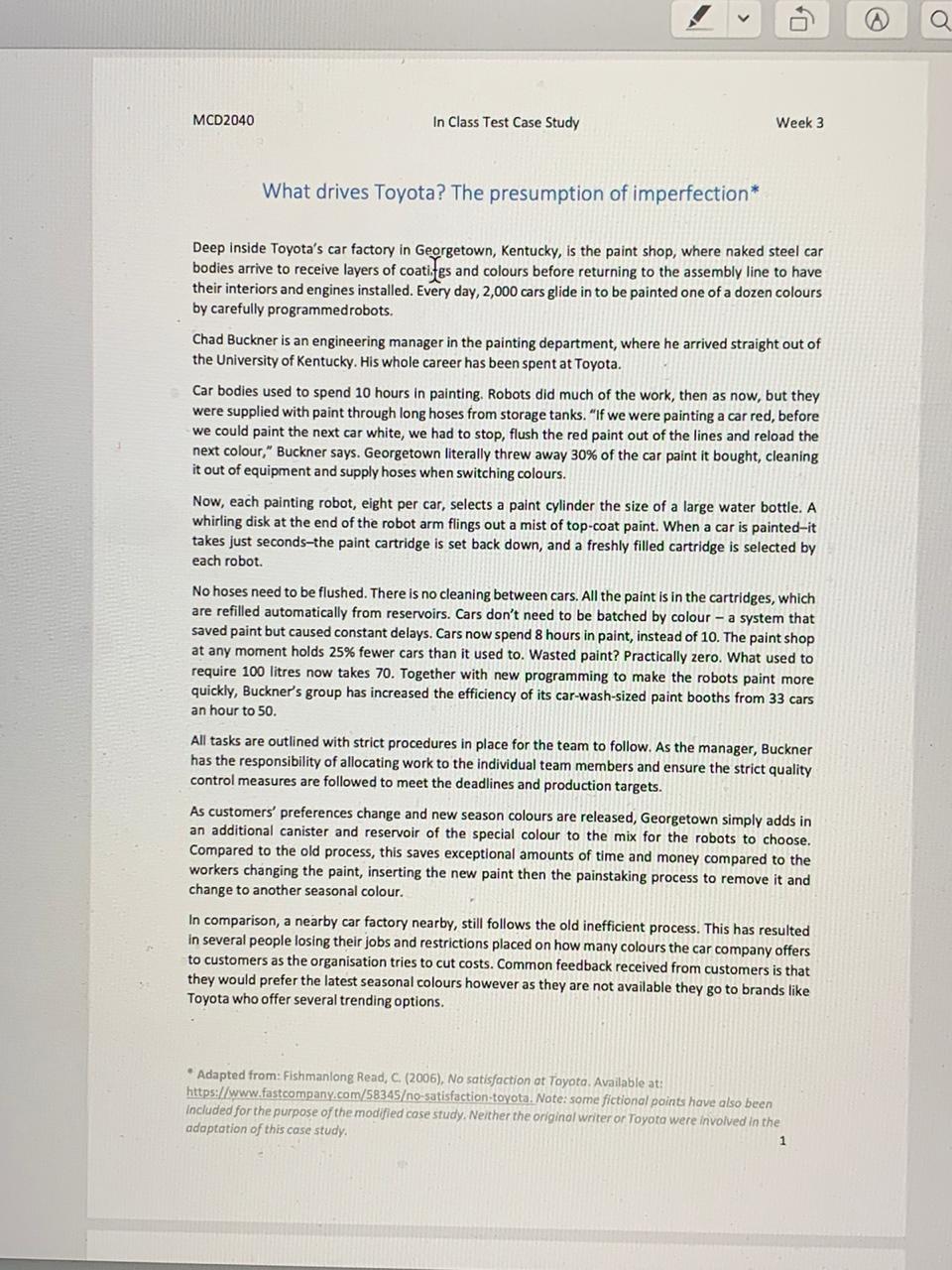Explain Weber's ideal Bureaucracy and ensure you discuss how at least two characteristics are practiced at Toyota Georgetown.
MCD2040 In Class Test Case Study Week 3 Howard Artrip, a manager in the assembly area, is telling the story of how they solved a decision- making problem. "There used to be eight racks of parts here," he says. The racks crowded the workstation, giving the worker ready access to all possible parts. The operator would eyeball the car coming up the line, step to the racks of visors and seat belts, and, says Artrip, "grab the right parts and run to the car." He or she would step into the slowly advancing car, bolt belts and visors in place, step back onto the factory floor-and do it again. All in 55 seconds, the time each slowly moving car spends at each workstation. The problem was, there were 12 possible combinations of sun visors and nine variations of seat belts. So just deciding which parts to snatch had become a job in itself. In every shift, 500 cars passed the racks, each car needing four specific parts: 2,000 opportunities to make an error. Even with 99% perfection, five cars per shift got the wrong sun visors or seat belts. The job of installing parts had become cluttered with meaningless decision making. So a team of assembly employees provided insights and made a critical decision. Don't make the worker pick the parts; let them focus on installing them. The idea seems obvious in retrospect: Deliver a kit of pre-sorted visors and seat belts with one kit per car, each containing exactly the right parts. The change came out of a routine analysis of dozens of assembly-line jobs at Georgetown. When the simplification effort started three years ago, Artrip's team found 44 jobs where assemblers had to make 1 or 2 decisions as they installed parts. They found 23 workstations that required between 7 and 11 decisions. Any jobs requiring 7 to 11 decisions in $5 seconds were going to cause problems. Now, 85 line jobs require just 1 or 2 decisions. Not a single job requires 7 or more decisions. The work is easier, the results are better. This is exactly the kind of work Artrip has spent more than half his career at Toyota doing: looking for ways to make the assembly line faster, simpler and safer, making it easier to do the work perfectly. Continuous improvement is not some add-on to the real work, it isn't some special project Artip does on top of the rest of his work. He does this every day, reviewing how they transform the input into an output and working out areas to improve. This emphasis on seeking perfection is because Toyota's senior executives constantly reinforce messages such as "Never be satisfied" and "There is always a better way". The company's foundation is built on constant improvement and innovation. Artrip has been at Georgetown for 19 years. The way he does his work is so compelling it has become part of his personal life. He has analysed his morning routine. "I do the same standardized work in the shower every morning. I have to get here at 6 a.m., and I know it takes 19 minutes, including walking into the plant." He smiles. "I've maximized my sleep time." Questions: 1. The case study highlights how Toyota Georgetown uses predominantly the first principle of Scientific Management. Choose two of the other three Scientific Management Principles and discuss how Toyota could use these more which would help improve production further. 2. Explain Weber's ideal Bureaucracy and ensure you discuss how at least two characteristics are practiced at Toyota Georgetown. 3. Discuss Systems Approach and explain why Toyota Georgetown is an open system.A Q MCD2040 In Class Test Case Study Week 3 What drives Toyota? The presumption of imperfection* Deep inside Toyota's car factory in Georgetown, Kentucky, is the paint shop, where naked steel car bodies arrive to receive layers of coatings and colours before returning to the assembly line to have their interiors and engines installed. Every day, 2,000 cars glide in to be painted one of a dozen colours by carefully programmedrobots. Chad Buckner is an engineering manager in the painting department, where he arrived straight out of the University of Kentucky. His whole career has been spent at Toyota. Car bodies used to spend 10 hours in painting. Robots did much of the work, then as now, but they were supplied with paint through long hoses from storage tanks. "if we were painting a car red, before we could paint the next car white, we had to stop, flush the red paint out of the lines and reload the next colour," Buckner says. Georgetown literally threw away 30% of the car paint it bought, cleaning it out of equipment and supply hoses when switching colours. Now, each painting robot, eight per car, selects a paint cylinder the size of a large water bottle. A whirling disk at the end of the robot arm flings out a mist of top-coat paint. When a car is painted-it takes just seconds-the paint cartridge is set back down, and a freshly filled cartridge is selected by each robot. No hoses need to be flushed. There is no cleaning between cars. All the paint is in the cartridges, which are refilled automatically from reservoirs. Cars don't need to be batched by colour - a system that saved paint but caused constant delays. Cars now spend 8 hours in paint, instead of 10. The paint shop at any moment holds 25% fewer cars than it used to. Wasted paint? Practically zero. What used to require 100 litres now takes 70. Together with new programming to make the robots paint more quickly, Buckner's group has increased the efficiency of its car-wash-sized paint booths from 33 cars an hour to 50. All tasks are outlined with strict procedures in place for the team to follow. As the manager, Buckner has the responsibility of allocating work to the individual team members and ensure the strict quality control measures are followed to meet the deadlines and production targets. As customers' preferences change and new season colours are released, Georgetown simply adds in an additional canister and reservoir of the special colour to the mix for the robots to choose. Compared to the old process, this saves exceptional amounts of time and money compared to the workers changing the paint, inserting the new paint then the painstaking process to remove it and change to another seasonal colour. In comparison, a nearby car factory nearby, still follows the old inefficient process. This has resulted in several people losing their jobs and restrictions placed on how many colours the car company offers to customers as the organisation tries to cut costs. Common feedback received from customers is that they would prefer the latest seasonal colours however as they are not available they go to brands like Toyota who offer several trending options. *Adapted from: Fishmanlong Read, C. (2006), No satisfaction at Toyota. Available at: https://www.fastcompany.com/58345o-satisfaction.toyota. Note: some fictional points have also been Included for the purpose of the modified case study. Neither the original writer or Toyota were involved in the adaptation of this case study. 1








